Polycarbonate filament’s exceptional strength comes from its unique molecular structure featuring carbonate groups and aromatic rings that create powerful intermolecular forces through π-π stacking interactions. You’ll find it delivers impressive 9,800 psi tensile strength and can support up to 685 pounds without failure. The flexible polymer chains absorb impact energy through molecular rearrangement rather than breaking, while its 150°C glass shift temperature maintains structural integrity under extreme conditions. This combination of properties explains why professionals choose it for mission-critical aerospace and automotive applications.
Molecular Structure and Polymer Chain Architecture
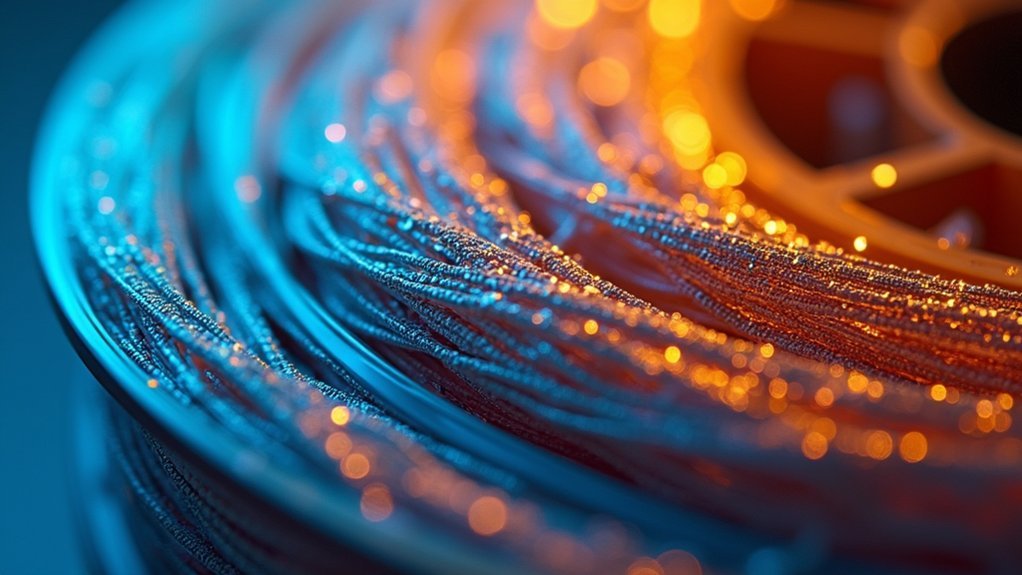
When you examine polycarbonate filament at the molecular level, you’ll find that its exceptional strength originates from a sophisticated polymer architecture built around carbonate groups (–O–(C=O)–O–) and a bisphenol A backbone.
The synthesis process involves phosgene reacting with bisphenol A, creating robust intermolecular forces throughout the polymer structure.
You’ll notice that aromatic rings within the polymer enhance strength through π-π stacking interactions, while the combination of aromatic and aliphatic components provides exceptional durability.
The polymer chain’s flexibility allows it to absorb impact without breaking, and methyl groups in bisphenol A create steric hindrance that boosts toughness.
Higher molecular weights increase intermolecular forces, and proper chain alignment during manufacturing maximizes the filament’s final strength and performance characteristics. The planar OC(OC) cores within the structure provide additional rigidity that contributes to the material’s impressive mechanical properties.
Tensile Strength Characteristics and Load-Bearing Capacity
Although polycarbonate’s molecular architecture provides the foundation for its strength, the material’s tensile strength characteristics reveal its true load-bearing potential in practical applications.
Polycarbonate’s exceptional tensile strength transforms theoretical molecular advantages into practical engineering solutions for demanding load-bearing applications.
You’ll find polycarbonate filament delivers approximately 9,800 psi tensile strength, considerably outperforming standard 3D printing materials. This exceptional strength translates to real-world capabilities—you can create parts that lift weights up to 685 pounds without failure.
Carbon fiber reinforced variants enhance these properties further, combining polycarbonate’s inherent toughness with carbon fiber’s stiffness.
The material’s high modulus of elasticity (1462 MPa) resists deformation under load, while its 143°C glass transformation temperature maintains strength in elevated thermal environments. Polycarbonate’s flame-retardant properties also contribute to its safety profile in demanding applications.
You’ll achieve consistent performance across different print orientations, making polycarbonate ideal for functional, load-bearing applications.
Impact Resistance and Energy Absorption Properties
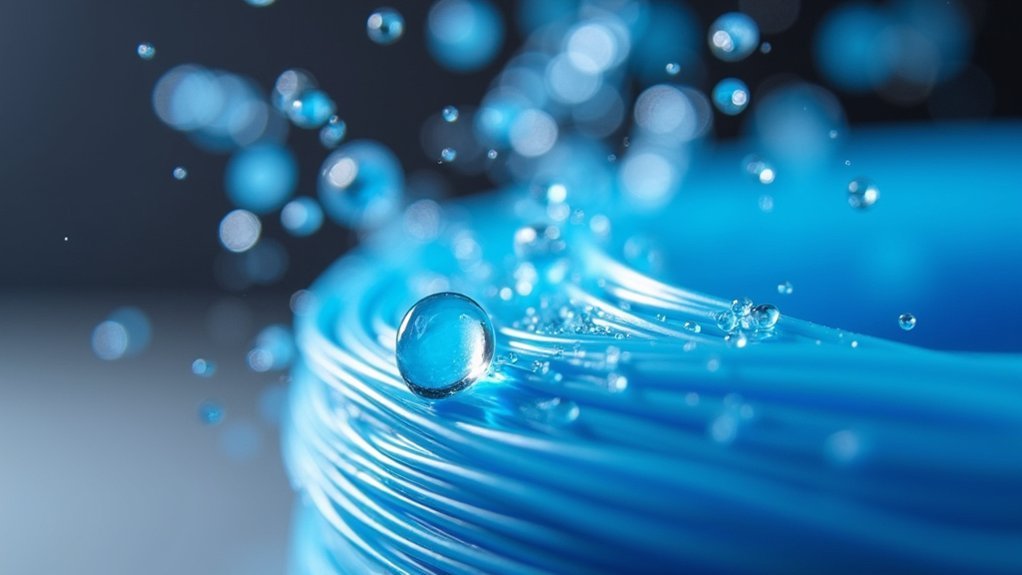
When you’re selecting polycarbonate filament for demanding applications, you’ll discover its exceptional ability to absorb high-impact forces without catastrophic failure.
The material’s molecular structure enables it to distribute energy across its entire surface area, effectively dissipating shock loads that would crack or shatter more brittle plastics.
This energy absorption capability makes your printed parts incredibly resilient against sudden impacts, repetitive stress, and dynamic loading conditions. Unlike rigid materials that fail through brittle fracture, polycarbonate can be bent without breaking, allowing it to flex under load and return to its original shape.
High Impact Absorption
Polycarbonate’s exceptional impact absorption capabilities stem from its unique molecular architecture, where long carbonate chains alternate with aromatic rings to create a backbone that’s both rigid and flexible.
This structure allows your printed parts to absorb massive amounts of kinetic energy through plastic deformation rather than catastrophic failure.
When impact occurs, you’ll notice how polycarbonate responds differently than brittle materials:
- Molecular chain rearrangement distributes stress across larger volumes instead of concentrating at failure points
- Strain energy conversion transforms kinetic impact into heat and molecular vibrations
- Plastic deformation capacity exceeds 50% strain-to-failure, letting parts bend rather than break
- Superior toughness retention maintains structural integrity under loads that shatter ABS or PLA
This energy absorption makes your components incredibly resilient against sudden shocks and heavy impacts. The material’s low warping characteristics further enhance its impact resistance by maintaining dimensional stability during stress distribution.
Energy Distribution Mechanisms
Understanding how polycarbonate distributes energy during impact requires examining its sophisticated molecular mechanisms that transform destructive forces into manageable deformation.
When you subject PC to stress, its amorphous structure enables polymer chains to undergo localized molecular motion, absorbing impact energy without fracturing. The aromatic rings provide backbone rigidity while maintaining flexibility, creating efficient energy dissipation pathways through reversible deformation rather than brittle failure.
You’ll benefit from PC’s viscoelastic properties that convert kinetic energy into heat through viscous flow within molecular chains. This time-dependent behavior blunts stress waves and distributes forces across the material. The material demonstrates elastic-plastic behavior with significant necking capabilities that further enhance energy absorption during deformation.
In 3D printing, strong interlayer adhesion reduces stress concentration sites, enabling uniform energy absorption. The balanced combination of molecular mobility and structural integrity makes polycarbonate exceptionally effective at managing destructive forces.
Glass Transition Temperature and Thermal Performance
You’ll find that polycarbonate’s glass change temperature of 150°C defines the critical point where the material shifts from a rigid, glassy state to a more flexible, rubbery condition.
This high Tg gives your printed parts exceptional thermal stability, allowing them to maintain their structural integrity and resist deformation even in demanding high-temperature environments. Beyond its glass transition point, polycarbonate demonstrates heat resistance up to 115°C for continuous operation.
Understanding this thermal behavior helps you predict how your polycarbonate components will perform when exposed to heat stress in real-world applications.
Glass Transition Explained
Temperature behavior fundamentally determines how polycarbonate filament performs in demanding applications. When you understand glass transformation temperature (Tg), you’ll grasp why polycarbonate maintains its strength where other materials fail. This critical temperature point marks when rigid, glassy material transforms into a flexible, rubbery state.
Polycarbonate’s impressive Tg of 145-150°C gives it exceptional advantages:
- Superior thermal stability – maintains structural integrity up to 150°C
- Outstanding performance gap – considerably outperforms PLA (55-60°C) and PETG
- Enhanced durability – resists deformation under heat stress
- Reliable consistency – performs predictably in high-temperature environments
You’ll find this high Tg essential for applications requiring thermal resistance. The molecular structure’s bridged phenylene rings create this thermal stability, making polycarbonate ideal for automotive, aerospace, and industrial components. Understanding Tg helps in selecting the right material for 3D printing projects based on their specific thermal requirements.
High Temperature Performance
When extreme heat threatens to compromise your 3D printed components, polycarbonate’s exceptional thermal performance delivers the reliability you need.
With a glass phase change temperature of approximately 150°C, polycarbonate maintains its structural integrity far beyond what most plastics can handle. You’ll find it remains heat-resistant up to 115°C in practical applications, making it ideal for demanding thermal environments.
The material’s high heat deflection contributes greatly to its durability under stress. Unlike materials that rapidly deform when heated, polycarbonate slowly softens, demonstrating remarkable thermal stability.
This controlled response to temperature changes guarantees your components won’t fail unexpectedly. The material’s thermal stability is vital for maintaining strength across varied conditions, giving you confidence in applications where temperature fluctuations are inevitable. During printing, polycarbonate requires high temperatures of 255-300°C for proper extrusion due to its robust thermal properties.
Crystalline Vs Amorphous Structure Effects on Strength
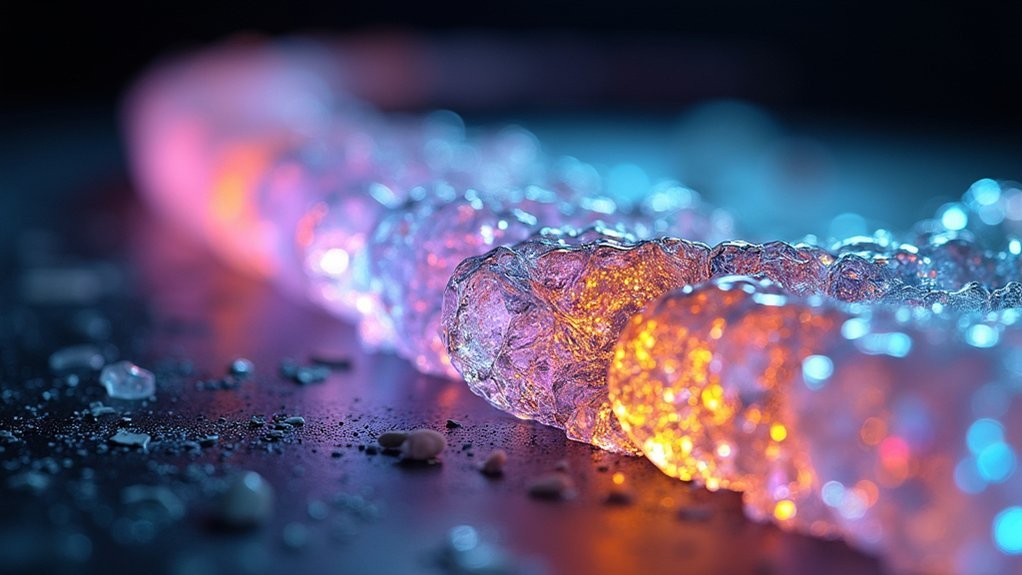
Although polycarbonate’s reputation centers on its exceptional toughness, the secret lies in its amorphous molecular structure that fundamentally differs from crystalline polymers.
You’ll find that PC’s randomly arranged polymer chains create distinct advantages over crystalline materials:
- Enhanced impact resistance – The disordered structure distributes stress evenly, preventing crack propagation that typically occurs in ordered crystalline regions.
- Superior energy absorption – Random chain orientations allow localized deformation and energy dissipation during impact events.
- Reduced brittleness – Without large crystalline domains, there aren’t stress concentration points that make materials prone to sudden failure.
- Balanced performance – While sacrificing some ultimate tensile strength, the amorphous structure optimizes toughness and flexibility.
This structural trade-off makes PC filament ideal when you need parts that withstand repeated impacts rather than maximum stiffness. The material’s elevated temperature tolerance stems from its high glass transition temperature of 150°C, making it suitable for demanding thermal environments.
Flexural Modulus and Bending Resistance
While polycarbonate’s amorphous structure delivers exceptional impact resistance, its flexural properties reveal another dimension of mechanical performance that’s essential for 3D printing applications. You’ll find that polycarbonate’s flexural modulus of 2.1-2.3 GPa markedly outperforms most common 3D printing materials, giving your printed parts superior resistance to bending forces.
| Material | Flexural Modulus |
|---|---|
| Polycarbonate | 2.1-2.3 GPa |
| PLA | 0.1-0.15 GPa |
| ABS | 2.1 GPa |
| PETG | 2.0 GPa |
| Nylon | 1.2-3.0 GPa |
This high flexural strength of 78-90 MPa means your PC parts won’t easily deform under bending stress. The material’s molecular structure creates exceptional stiffness while maintaining toughness, making it ideal for functional prototypes, mechanical components, and applications where dimensional stability under load is critical. When accessing comprehensive materials data for polycarbonate specifications, premium databases offer enhanced search capabilities for comparing mechanical properties across different manufacturers.
Layer Adhesion and Inter-Layer Bonding Strength
You’ll find that polycarbonate’s layer adhesion strength fundamentally depends on molecular chain entanglement occurring at the interface between deposited layers.
The bonding process is highly temperature-dependent, requiring ideal heat conditions to achieve sufficient polymer chain diffusion and fusion across layer boundaries.
Understanding these interlayer mechanical properties becomes critical since adhesion strength typically measures 25-35 MPa—significantly lower than the material’s inherent tensile strength of 68-71 MPa. Proper drying of the filament can improve layer adhesion by up to 73%, demonstrating the importance of moisture control in achieving optimal bonding strength.
Molecular Chain Entanglement
When polycarbonate chains entangle at the molecular level, they create the foundation for strong layer adhesion that determines your filament’s overall structural integrity.
These molecular entanglements act like microscopic hooks, preventing brittle fracture and creating robust interlocking networks between printed layers.
The strength of your polycarbonate filament depends on several entanglement factors:
- Chain length impact – Longer polymer chains provide more entanglement opportunities, directly increasing material strength and preventing layer delamination.
- Molecular orientation – Extrusion-induced chain alignment enhances interlayer bonding by promoting directional molecular interlocking across layer boundaries.
- Entanglement density – Higher molecular weight creates denser chain networks that resist disentanglement crazing and structural failure.
- Surface interaction – Entangled chains at layer interfaces form strong interfacial bonds that maintain structural cohesion under mechanical stress.
Processing conditions can significantly degrade these entanglements through heat and shear forces that break polymer chains, reducing the material’s impact resistance and overall toughness.
Temperature-Dependent Fusion Process
As polycarbonate filament reaches its ideal extrusion temperature of 260°C to 310°C, the heat energy transforms solid polymer chains into a viscous state that enables critical molecular mobility for layer fusion.
You’ll find that this thermal energy transfer creates favorable conditions for previously deposited layers to rebond with incoming material. The high temperatures increase molecular interaction at layer interfaces, ensuring strong inter-layer adhesion that’s essential for structural integrity.
Your print bed temperature of 110°C to 135°C maintains this fusion process by preventing rapid cooling that would inhibit proper bonding.
When you combine adequate pressure with these elevated temperatures, you’re facilitating uniform filament flow that creates seamless layer integration. This temperature-dependent process directly determines your print’s mechanical strength and dimensional stability. The resulting parts exhibit exceptional impact resistance, allowing them to bend under stress without breaking or fracturing.
Interlayer Mechanical Properties
While temperature creates the initial conditions for fusion, the actual mechanical strength of your polycarbonate print depends on how effectively adjacent layers bond at the molecular level. This interlayer adhesion determines whether your finished part will withstand real-world stresses or fail along layer lines.
Several critical factors influence your print’s interlayer bond strength:
- Molecular weight – Lower molecular weight polycarbonate creates better diffusion between layers due to reduced viscosity.
- Extrusion temperature – Higher temperatures increase melt flow and enhance molecular diffusion across layer boundaries.
- Material humidity – Moisture compromises layer adhesion, requiring proper filament storage and handling.
- Build plate temperature – While improving crystallinity, excessive heat can negatively impact interlayer bonding under certain conditions.
Achieving ideal layer adhesion without compromising print quality requires precise control over these interconnected variables. Polycarbonate filament delivers great layer bonding that contributes significantly to the overall structural integrity of printed parts.
Print Temperature Effects on Mechanical Properties
Since polycarbonate’s mechanical performance depends heavily on achieving proper interlayer fusion, you’ll find that print temperature serves as the most critical parameter for maximizing your filament’s strength potential.
Your ideal temperature range spans 240°C to 285°C, with sweet spots around 260°C delivering maximum tensile strength up to 63 MPa and Young’s modulus reaching 2010 MPa.
When you print below 240°C, you’ll encounter poor layer adhesion and increased brittleness. Conversely, exceeding 285°C risks filament degradation and print defects.
Higher temperatures improve interlayer diffusion, boosting your impact resistance up to 64 kJ/m². You’ll also notice that proper temperature control reduces mechanical anisotropy, strengthening z-direction layers while maintaining polycarbonate’s exceptional heat resistance properties.
The material’s high impact resistance makes it particularly suitable for engineering applications requiring durability under mechanical stress.
Comparative Strength Analysis Against Other Engineering Filaments
When you’re selecting engineering filaments for demanding applications, polycarbonate consistently outperforms most alternatives in tensile strength, delivering up to 70 MPa compared to ABS’s modest 32 MPa and PLA’s 50 MPa.
PC’s mechanical superiority extends beyond basic tensile strength. You’ll find it offers exceptional impact resistance and maintains structural integrity under stress better than most consumer-grade materials. Professional users worldwide rely on PC filament for critical applications where failure is not an option, making it a preferred choice among engineers and innovators.
While PEEK exceeds PC at 100+ MPa, it’s considerably more expensive and harder to process.
Here’s how PC stacks up against key competitors:
- Superior stiffness compared to ABS and PLA for rigid applications
- Better heat deflection than PETG while maintaining comparable strength
- Higher hardness rating than nylon without carbon fiber reinforcement
- Excellent temperature resistance surpassing most standard engineering plastics
Real-World Applications Demonstrating Superior Strength Performance
Across aerospace, automotive, and medical industries, polycarbonate filament’s exceptional strength characteristics translate into mission-critical components that demand unwavering reliability.
You’ll find this material creating safety-critical aircraft brackets that withstand extreme temperatures and structural loads, while its high impact resistance makes it ideal for automotive headlight housings that endure road debris impacts.
In medical applications, you’re seeing polycarbonate’s superior strength enable precise surgical guides and durable prosthetics that handle daily stress.
The aerospace industry leverages its strength-to-weight ratio for lightweight structural parts, while automotive manufacturers trust it for dashboard components exposed to engine heat. Electronics manufacturers rely on polycarbonate’s durability for protective covers that shield sensitive components from environmental hazards.
These real-world implementations prove polycarbonate’s strength isn’t just theoretical—it’s delivering measurable performance where failure isn’t an option.
Frequently Asked Questions
How Much More Expensive Is Polycarbonate Filament Compared to PLA or ABS?
You’ll pay considerably more for polycarbonate filament than PLA or ABS due to its advanced properties and complex manufacturing process, though exact pricing varies by brand and quality.
What Specific Printer Settings Are Needed for Successful Polycarbonate Printing?
You’ll need extruder temperatures between 260-310°C, heated bed at 90-120°C, minimal cooling fans, slower print speeds of 30-50mm/s, and an enclosed chamber maintaining 60-80°C for successful polycarbonate printing.
Can Polycarbonate Filament Be Recycled After Failed Prints or Prototyping?
You can recycle polycarbonate filament, but it’s challenging. You’ll need specialized facilities due to its chemical resistance and strength. Mechanical recycling isn’t common, making proper disposal through dedicated programs essential.
How Long Does Polycarbonate Filament Last When Stored Properly?
When you store polycarbonate filament properly at room temperature with humidity below 15% in airtight containers with desiccants, you’ll extend its shelf life up to 24 months while maintaining peak quality.
What Safety Precautions Should Be Taken When Printing With Polycarbonate Filament?
You’ll need protective gear like gloves and safety glasses, guarantee proper ventilation for fumes, use a compatible high-temperature printer, maintain controlled environments, and handle the filament carefully to avoid contamination.
In Summary
You’ll find that polycarbonate filament’s exceptional strength stems from its unique molecular architecture, high glass change temperature, and superior inter-layer bonding. When you’re printing with proper temperatures, you’re creating parts that outperform most engineering plastics in tensile strength and impact resistance. Whether you’re building functional prototypes or end-use components, PC filament’s amorphous structure and excellent layer adhesion deliver the mechanical properties you need for demanding applications.
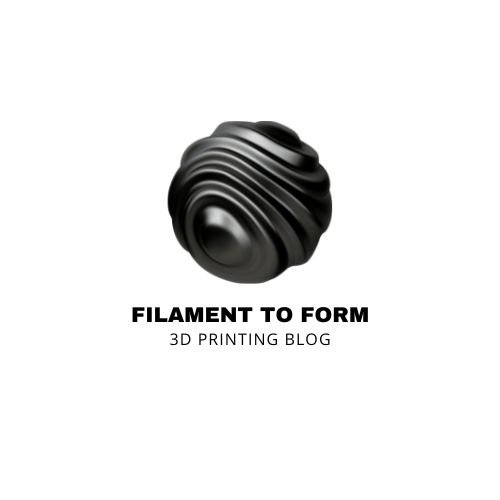



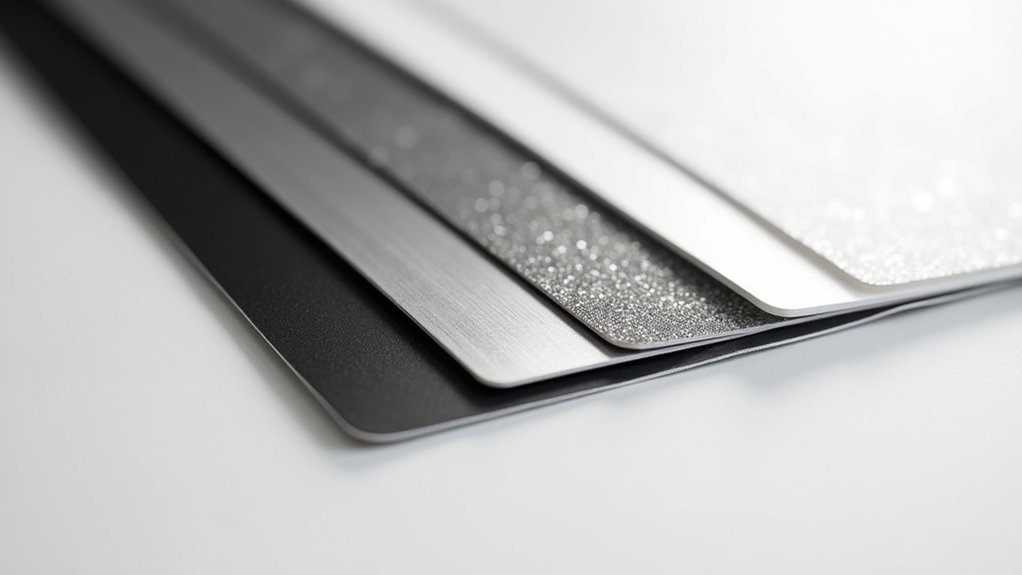
Leave a Reply